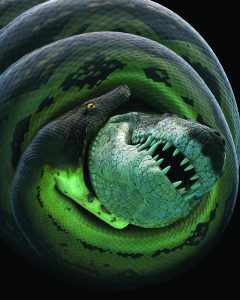A new University of Florida study describes a 16-foot, 900-pound ancient species of crocodilian that swam in the same rivers as Titanoboa 60 million years ago in the world’s oldest-known rain forest.

Image courtesy of the Smithsonian Channel
The newly named reptile, which has an unusually blunt snout for species in the dyrosaurids family, lived alongside the 58-foot Titanoboa as portrayed in the Smithsonian Channel documentary on the ‘monster snake.’ Scientists assigned the species’ name, Anthracosuchus balrogus, in a study appearing online today in the journal Historical Biology. Unearthed from the same layer of rock as Titanoboa in the Cerrejon coal mine of northern Colombia, the species is named for a ferocious fictional creature (the “Balrog”) that appeared in J.R.R. Tolkien’s novel “The Lord of the Rings” and dwelled deep in the middle-Earth “Mines of Moria.”
The new species opens a window to the early adaptability and diversity of tropical crocodyliforms, which may help scientists better understand how living crocodiles adapt to changing environments today, said lead author Alex Hastings, a post-doctoral researcher at Martin Luther Universität Halle-Wittenberg and former graduate student at the Florida Museum of Natural History and UF’s department of geological sciences.
“It quickly became clear that the four fossil specimens were unlike any dyrosaur species ever found,” Hastings said, noting the species’ short snout paired with large jaw muscles typical of dyrosaurids, would give it an incredibly powerful bite. “Everyone thinks that crocodiles are living fossils that have remained virtually unchanged for the last 250 million years. But what we’re finding in the fossil record tells a very different story.”
Co-author and Florida Museum associate curator of vertebrate paleontology Jonathan Bloch said researchers were “stunned” when they first saw the new species.
“We couldn’t believe it had such a boxy, short skull and that it was still a dyrosaur,” Bloch said. “It really busts the mold for these animals. It is such a completely different looking beast than we’ve seen for these crocodile-like animals.”
The study of dyrosaurids in Cerrejon is providing a better understanding of the early history of crocodiles in the Neotropics, said paleobotanist and study co-author Carlos Jaramillo of the Smithsonian Tropical Research Institute.
“This new finding showcases the wide range of ecological variation that tropical crocodiles already had by 60 million years ago—much larger than modern Neotropical crocodile faunas,” Jaramillo said.
The animal is the third new species of ancient crocodilian pulled from Cerrejon, one of the world’s largest open-pit coal mines. Originating in Africa, the dyrosaurids swam across the Atlantic Ocean to South America about 75 million year ago. The family somehow survived the extinction event that wiped out the dinosaurs and persisted to become a top predator, Hastings said.
“This group offers clues as to how animals survive extinctions and other catastrophes,” Hastings said. “As we face climates that are warmer today, it is important to understand how animals responded in the past. This family of crocodyliforms in Cerrejon adapted and did very well despite incredible obstacles, which could speak to the ability of living crocodiles to adapt and overcome.”
The crocodyliforms that lived in the Cerrejon ecosystem during the Paleocene, when temperatures were higher than today, thrived and grew to enormous sizes, Bloch said. Dyrosaurids were commonly ocean-dwellers, but the new species lived in freshwater rivers, ate turtles and fish and would have lived in close proximity to Titanoboa. However, the giant snake would have been a formidable threat to A. balrogus with the tremendous grip of its constricting coils, he said.
“Every once in a while, there was likely an encounter between Anthracosuchus and Titanoboa,” Bloch said. “Titanoboa was the largest predator around and would have tried to eat anything it could get its mouth on.”
Paleontologist Stéphane Jouve with the Natural History Museum of Marseille said the exceptionally short and robust snout of A. balrogus is probably related to its wide range of diet. Although some species of dyrosaurids have slightly different morphologies, only A. balrogus has a short and relatively wide snout that resembles some existing crocodiles, he said.
“In the future, it would be interesting to determine if the short-snouted species forms an independent dyrosaurid group, or an intermediate morphology between the slender-snouted pholidosaurids and slender-snouted dyrosaurids,” Jouve said.
These ancient species from the oldest rain forest are exposing the foundations of tropical ecosystems, Bloch said. A. balrogus was ecologically very similar to crocodiles in the Amazon today, while Titanoboa was somewhat like a modern anaconda—aquatically adapt, with a diet of crocodyliforms, turtles and fish.
“In a lot of ways, the ecological diversity that we see in these dyrosaurids mirrors the overall diversity that we see in crocodiles today,” Bloch said.
Learn more about the Vertebrate Paleontology Collection at the Florida Museum.